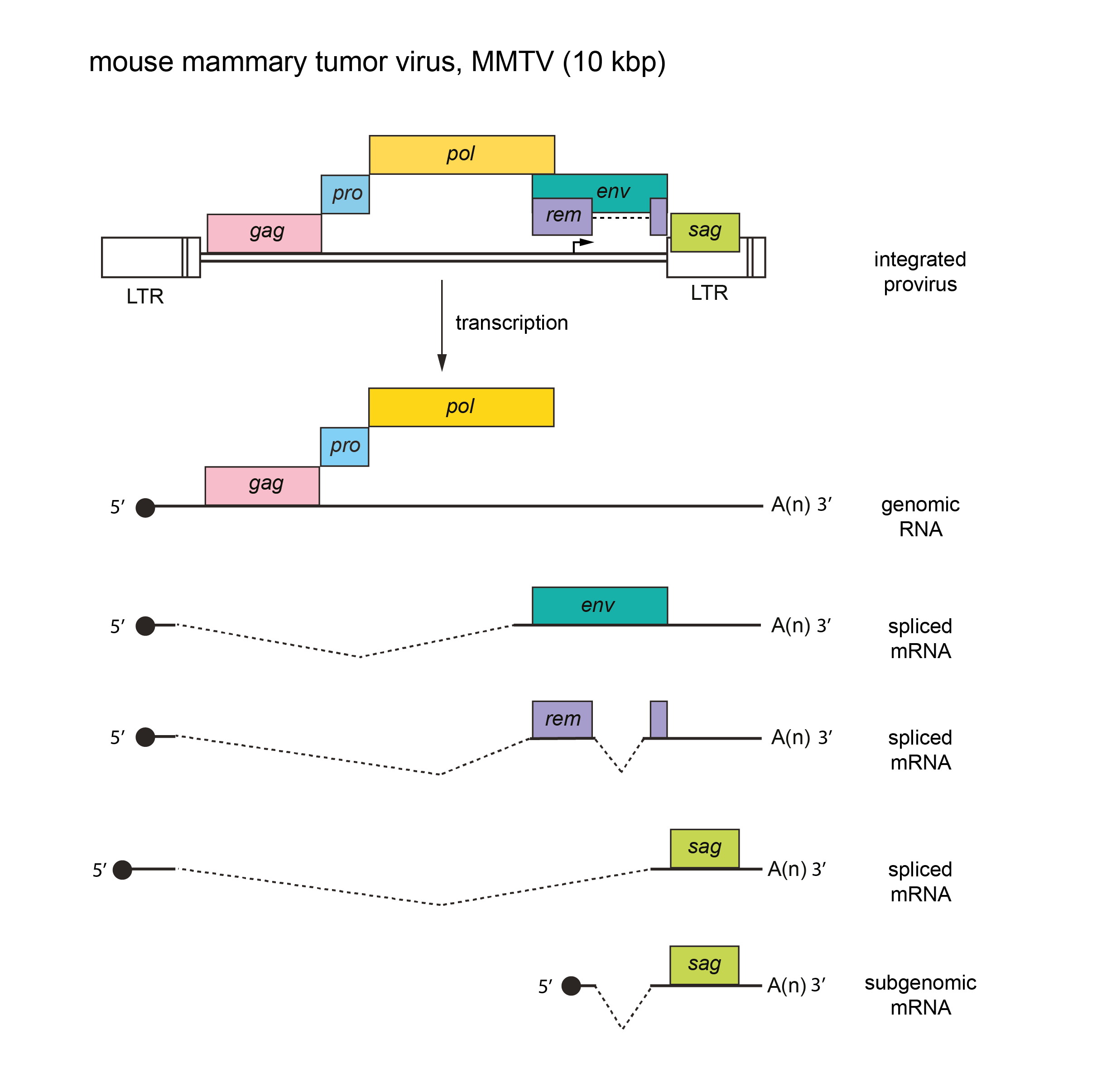Subfamily: Orthoretrovirinae
Genus: Betaretrovirus
Distinguishing features
Virions can have “B-type” or “D-type” morphology, depending on the species. Genomes typically contain an additional regulatory gene that overlaps with the env gene and is encoded by a multiply-spliced mRNA – examples include the rem gene of MMTV and the rej gene of JSRV.
Virion
Morphology
Virions of mouse mammary tumor virus (MMTV) exhibit a “B-type” morphology with prominent surface spikes and an eccentric condensed core. Other members of the genus have a “D-type” morphology with fewer dense surface spikes and a cylindrical core. Those with a B-type morphology lack an inter-subunit disulfide bond between the surface (SU) and transmemberane (TM) envelope protens, whereas those with a “D-type” morphology have env genes likely derived by recombination with a gammaretrovirus, and consequently, these have a disulfide bond linking the SU and TM subunits (Henzy and Coffin 2013, Henzy and Johnson 2013). Capsid assembly occurs within the cytoplasm (to yield structures previously termed “A-type” particles) prior to transport to, and budding from, the plasma membrane.
Physicochemical and physical properties
See discussion under family description.
Nucleic acid
See discussion under family description.
Proteins
Approximate protein sizes are: matrix protein (MA) 10 kDa; p21 21 kDa; p8/p12 8 kDa or 12 kDa; capsid protein (CA) 27 kDa; nucleocapsid protein (NC) 14 kDa; dUTPase (DU) 30 kDa; protease (PR) 15 kDa; reverse transcriptase (RT) 50 kDa; integrase (IN) 36 kDa; surface subunit (SU) 52 kDa; and transmembrane subunit TM 36 kDa.
Genome organization and replication
The genome is 8–10 kb (one monomer); its organization in MMTV is illustrated in Figure 1. Betaretrovirus. In MMTV there are two additional genes: sag, whose product functions as a superantigen, is located at the 3′-end of the genome, overlapping U3 and rem, which encodes an RNA export protein (Rem) and is translated from a doubly spliced mRNA overlapping the env gene. The sag gene is absent from other members of the genus, but several other viruses encode activities analogous to Rem. The tRNA primer is tRNALys-3 for MMTV and tRNALys-1,2 for other members of the genus. The long terminal repeat (LTR) of MMTV is about 1300 nt, primarily comprising the sag-encoding U3 region of 1200 nt. The R sequence (15 nt) and the U5 region (95–120 nt) are of similar length in all members of the genus.
 |
| Figure 1. Betaretrovirus. Betaretrovirus genome organization. The 10 kbp mouse mammary tumor virus (MMTV) provirus genome is shown, with LTRs, genes (gag, pro, pol, env, sag and rem) and transcripts (solid line arrows with protein names added) marked. The pro and pol genes are expressed as a result of ribosomal frameshifts |
Biology
Viruses assigned to this genus include exogenous (milk-transmitted) and endogenous viruses of mice, as well as exogenous, horizontally transmitted and endogenous viruses of New and Old World primates and sheep. Murine viruses are associated with mammary carcinoma and T-lymphomas, whereas the exogenous primate viruses are associated with immunodeficiency diseases and Jaagsiekte sheep retrovirus is associated with pulmonary cancer of sheep (Hofacre and Fan 2010, Montiel 2010, Palmarini et al., 2004, Ross 2010). No oncogene-containing member is known. Endogenous proviruses related to the betaretroviruses have been identified in the genomes of a wide variety of mammalian species, ranging from marsupials to primates (including humans), indicating that viruses in this genus may have a much broader host range than is represented by currently classified betaretroviruses (Hayward et al., 2015, Henzy and Johnson 2013, Garcia-Montojo et al., 2018, Gifford et al., 2005, Hohn et al., 2013). There is currently no evidence for betaretroviruses in non-mammalian hosts.
Species demarcation criteria
Species demarcation criteria include differences in genome sequence, differences in gene product sequences, and differences in natural host range. For example, mouse mammary tumor virus (MMTV) is assigned to a separate species because of the unique sag coding region and a widely divergent and distinct env gene. Jaagsiekte sheep retrovirus (JSRV) is also assigned to a separate species on the degree of nucleotide sequence divergence.
Several primate retroviruses have been described that are divergent members deriving from a recombination event in which the env gene of a primate gammaretrovirus was captured by a betaretrovirus (Henzy and Johnson 2013). Thus, these are unique among betaretroviruses in that the SU and TM subunits of Env are covalently linked by a disulfide bond, similar to gammaretroviruses. These include closely related isolates of the species Mason-Pfizer monkey virus, such as Mason-Pfizer monkey virus, simian retrovirus-1, and simian retrovirus-2, which are still serologically distinct, as well as the serologically more divergent endogenous squirrel monkey retrovirus (SMRV, a member of the species Squirrel monkey retrovirus) and langur virus (LNGV, a member of the species Langur virus).
Related, unclassified viruses
|
Virus name |
Accession number |
Abbreviation |
|
enzootic nasal tumor virus |
|
ENTV |
Virus names and virus abbreviations are not official ICTV designations.
An unclassified virus closely related to JSRV, enzootic nasal tumor virus (ENTV), induces nasal adenocarcinoma in goats and sheep.

